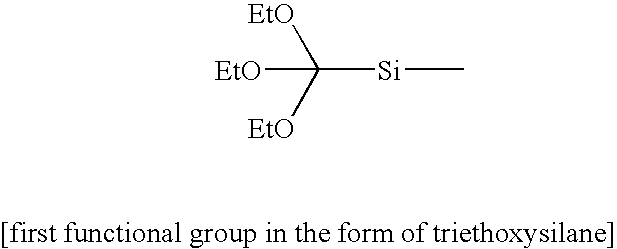Stamp having an antisticking layer and a method of forming of repairing such a stamp
a technology of anti-sticking layer and stamp, which is applied in the field of stamp having an anti-sticking layer and a forming method of repairing such a stamp, can solve the problems of insufficient stability of film, deterioration of film quality in embossing, and damage to the stamp reproduced on the plate, so as to achieve stable anti-sticking layer, easy to recreate anti-sticking properties, and more sensitive to sticking
- Summary
- Abstract
- Description
- Claims
- Application Information
AI Technical Summary
Benefits of technology
Problems solved by technology
Method used
Image
Examples
example 1
A stamp made of silicon was etched to form a nanostructured pattern. The stamp was washed with, in succession, trichloroethylene, ethanol and isopropanol. The stamp was subsequently dipped into a beaker with hexane at room temperature with 0.2% mercaptopropyltriethoxysilane, which corresponded to an excess amount of mercaptopropyltriethoxysilane, and was allowed to react for 4 h. The stamp was then removed from the beaker and cleaned with, in succession, trichloroethylene, ethanol and isopropanol. The stamp was dried and subsequently placed in a beaker, which contained hexane at room temperature with 2% 1H, 1H, 2H, 2H-perfluorooctanethiol. After 16 h, the stamp was removed from the vessel, washed with hexane in three successive baths and then dried. The stamp was tested in a nanoimprint lithography process and was found to resist 50 embossings without any particular signs of wear being detected.
example 2
A stamp made of silicon was patterned and washed in the manner described in Example 1. The stamp was subsequently placed in an oven, which had a temperature of 200° C. and was evacuated to a pressure of 1 kPa. Mercaptopropyltriethoxysilane was injected in large excess into the oven and vaporised. The stamp was allowed to react with the mercaptopropyltriethoxysilane for 3 h and was then removed from the oven and allowed to cool. The stamp was cleaned and treated with 1H, 1H, 2H. 2H-perfluorooctanethiol in liquid phase in the manner described in Example 1. The stamp was tested in a nanoimprint lithography process and was found to resist 50 embossings without any particular signs of wear being detected.
example 3
The experiment in Example 2 was repeated with materials and reagents according to Table 1:
TABLE 1Combinations of materials and compounds used in Example 3.Surface ofthe stampFirst reagentSecond reagentSi(MeO)3Si(CH2)3NH2Cl(C═O)(CH2)2C(CF3)3SiCl3Si(CH2)3SHSH(CH2)2(CF2)7CF3Si(EtO)3Si(CH2)3OHHO(C═O)(CH2)2(CF2)2CF3Al(MeO)3Si(CH2)3SHSH(CH2)2(CF2)5CF3AlCl3Si(CH2)3SHSH(CH2)2(CF2)2CF3Ni*(EtO)3Si(CH2)3SHSH(CH2)2(CF2)5CF3Ti(EtO)3Si(CH2)3SHSH(CH2)2(CF2)5CF3
*The surface of Ni was first treated with an oxygen plasma to oxidise the surface.
The finished stamps were tested in a nanoimprint lithography process and all of them were found to resist 50 embossings without any particular signs of wear being detected.
PUM
| Property | Measurement | Unit |
|---|---|---|
| Length | aaaaa | aaaaa |
Abstract
Description
Claims
Application Information
 Login to View More
Login to View More - R&D
- Intellectual Property
- Life Sciences
- Materials
- Tech Scout
- Unparalleled Data Quality
- Higher Quality Content
- 60% Fewer Hallucinations
Browse by: Latest US Patents, China's latest patents, Technical Efficacy Thesaurus, Application Domain, Technology Topic, Popular Technical Reports.
© 2025 PatSnap. All rights reserved.Legal|Privacy policy|Modern Slavery Act Transparency Statement|Sitemap|About US| Contact US: help@patsnap.com



